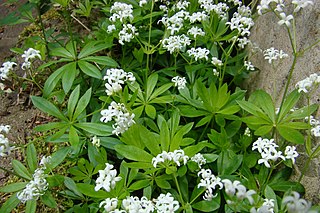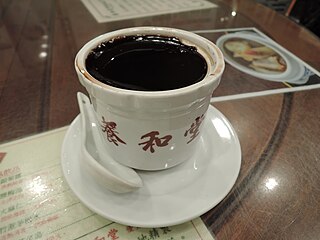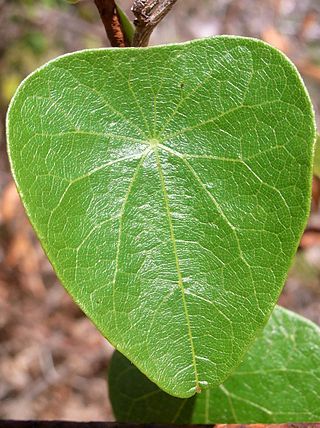
Petroleum jelly, petrolatum, white petrolatum, soft paraffin, or multi-hydrocarbon, CAS number 8009-03-8, is a semi-solid mixture of hydrocarbons, originally promoted as a topical ointment for its healing properties. Vaseline has been an American brand of petroleum jelly since 1870.

Galium odoratum, the sweet woodruff or sweetscented bedstraw, is a flowering perennial plant in the family Rubiaceae, native to much of Europe from Spain and Ireland to Russia, as well as Western Siberia, Turkey, Iran, the Caucasus, China and Japan. It is also sparingly naturalised in scattered locations in the United States and Canada. It is widely cultivated for its flowers and its sweet-smelling foliage.

Grass jelly, also known as leaf jelly or herb jelly, is a jelly-like dessert originating from China. It is commonly consumed in East Asia and Southeast Asia. It is created by using Chinese mesona and has a mild, slightly bitter taste. Grass jelly was invented by the Hakka people who historically used the food to alleviate heat stroke after long days working in the field. The dish was introduced to Southeast Asia by the Chinese diaspora. It is served chilled, with other toppings such as fruit, or in bubble tea or other drinks. Outside Asia, it is sold in Asian supermarkets.

Guilinggao, also known as tortoise jelly or turtle powder, is a jelly-like Chinese medicine, also sold as a dessert. It was traditionally made from the gao, or paste of the plastron from the turtle Cuora trifasciata and a variety of herbal products, in particular, China roots Smilax glabra . Although the critically endangered golden coin turtle is commercially farmed in modern China, it is extremely expensive; therefore, even when turtle-derived ingredients are used in commercially available guilinggao, they come from other, more commonly available, turtle species.
The Ferrara Candy Company is an American candy manufacturer, based in Chicago, Illinois, and owned by the Ferrero Group.

Jelly's Last Jam is a musical with a book by George C. Wolfe, lyrics by Susan Birkenhead, and music by Jelly Roll Morton and Luther Henderson. Based on the life and career of Ferdinand Joseph LaMothe, known as Jelly Roll Morton and generally regarded as one of the primary driving forces behind the introduction of jazz to the American public in the early 20th century, it also serves as a social commentary on the African-American experience during the era. LaMothe was born into a Louisiana Creole family that was established and free before the Civil War.

The Hunt–Morgan House, historically known as Hopemont, is a Federal style residence in Lexington, Kentucky built in 1814 by John Wesley Hunt, the first millionaire west of the Alleghenies. The house is included in the Gratz Park Historic District. The Alexander T. Hunt Civil War Museum is located on the second floor of the Hunt–Morgan House.

Aiyu jelly, known in Amoy Hokkien as ogio, and as ice jelly in Singapore, is a jelly made from the gel from the seeds of the awkeotsang creeping fig found in Taiwan and East Asian countries of the same climates and latitudes. The jelly is not commonly made or found outside of Taiwan, Malaysia, and Singapore, though it can be bought fresh in specialty stores in Japan and canned in Chinatowns. It is also used in Taiwanese cuisine.

Chinese desserts are sweet foods and dishes that are served with tea, along with meals or at the end of meals in Chinese cuisine. The desserts encompass a wide variety of ingredients commonly used in East Asian cuisines such as powdered or whole glutinous rice, sweet bean pastes, and agar. Due to the many Chinese cultures and the long history of China, there are a great variety of desserts of many forms.

Platostoma palustre, commonly known as Chinese mesona, is a species of plant belonging to the genus Platostoma of the mint family. The species grows extensively in East Asia such as south east China, Japan and Taiwan preferring ravines, grassy, dry, and sandy areas. The plants are from 15 to 100 cm high with hairy stems and leaves. The leaves are tear-drop shaped and serrated.

Adventures in Preservation, formerly named Heritage Conservation Network, is a non-profit organization dedicated to safeguarding the world’s architectural heritage. Its programs give volunteers from all walks of life the opportunity to be involved in preservation in a variety of hands-on ways.

Es teler is an Indonesian fruit cocktail. Avocado, coconut meat, grass jelly, jackfruit and other fruits are served with coconut milk, sweetened condensed milk, Pandanus amaryllifolius leaf, sugar, and a tiny amount of salt.

Stephania japonica, known as snake vine, is a vine often seen in sheltered areas near the sea.

Es buah is an Indonesian iced fruit cocktail dessert. This cold and sweet beverage is made of diced fruits, such as honeydew, cantaloupe, pineapple, papaya, squash, jackfruit and kolang kaling, mixed with shaved ice or ice cubes, and sweetened with liquid sugar or syrup. The type of fruit used in this dessert may vary, some might add any available fruits such as mango, watermelon or longan — some imported fruits — such as lychee, kiwi, strawberry, pear, peach or grapes. Other ingredients might be added too, such as agar-agar jelly, grass jelly, seaweed or nata de coco.

Jason Bradley DeFord, known professionally as Jelly Roll, is an American rapper, singer, and songwriter from Antioch, Tennessee. Beginning his career in 2003, he rose to mainstream prominence in 2022 following the release of two singles, "Son of a Sinner" and "Need a Favor".

O-aew is a shaved ice dessert known as a local specialty of Phuket, Thailand. Introduced by Hokkien Chinese settlers, it is known after its main ingredient, a jelly made from seeds of the o-aew plant, an ingredient now most commonly found in Taiwan where it is known as aiyu jelly.















